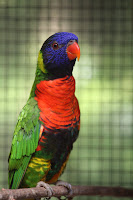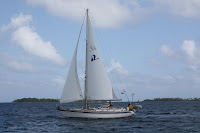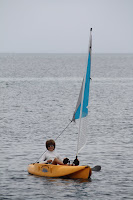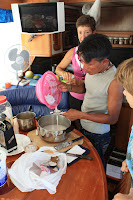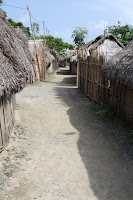Sunday, February 28, 2010
Genes – Some not so good
Unfortunately, not all inherited traits are good. Dad started wearing glasses at 3rd grade and he has been testing Emily for the past couple of years…All very scientific, of course. We’ll go to the mall and I’ll say “see that sign way over there? What does it say?” Some times she will answer “Dad, signs can’t say anything because they don’t speak”, but some times she will actually tell me. Well, here in Panama, she failed Dad’s test and earned a seat in an Optician’s chair.
Five days later she is wearing her new glasses and is thrilled with the restored clarity. Her eyes were not too bad, but it was good to get them here while we had the chance. Here is a picture of her with her new glasses.
We both think she looks pretty good.
We are still mostly proud of the genes we have passed on but I’m not looking forward to the day her full beard comes in!
Dad
Saturday, February 27, 2010
The Tsunami Two-Step
Monday, February 22, 2010
Test
This is a test post from my SSB radio. I am sending this post via my ship radio. If this works, I may be able to post notes far out a sea for all to read.
Tom
MV Emily Grace
Monday, February 15, 2010
Another Way to Track Us
The device that seems to work pretty good is our Single Side Band (SSB) radio. We turn it on almost every day to get weather or talk to other cruisers and it can also send and receive e-mails. We keep that address closely, because it takes about 15 to 20 minutes just to download the weather. We sure don't need any junk mail!
But I've been experimenting with a feature of the SSB that lets me upload my current position each time I connect to get my e-mail and weather. We have been leaving position reports since we left Trinidad and it seems to work pretty good. We found a website where anyone can just type in our HAM radio call sign (which is K1MMY) and get a nice plot of our track and last reported position. It gives neat little red dots where we have been and a nice big water drop where we were the last time we checked in. It looks just like this:

The website can be found here http://www.shiptrak.org/
You just need to type in our call sign which is k1mmy (note the i in k1mmy is the number 1) and either click the VIEW button or hit the ENTER key on the computer. The website starts putting in the little red dots in the order we traveled. You can zoom in or move the map around to look closer.
Try it out and let me know if you have any problems. It will allow any of our Dear Readers to at least see that we are making our way across the Pacific even if we don't have the ability to call or e-mail.
And thanks to all of you readers that tuned in and watched us go through the Panama Canal. The winner for best picture captured goes to John Swiatek. John was at the "Penny Factory" on my first day of work back in 1980, the day I retired, and for some reason is still working.
Here's the winning shot of Emily Grace going through the Miraflores Lock and just about to enter the Pacific Ocean.

Saturday, February 13, 2010
Panama Canal Transit Announcement

Our little ship will be going through the Panama Canal this coming weekend. There is a live web camera on several positions along the canal.
We should be gong through the Gatun locks on Saturday (2-13) between 6 PM and 9 PM. But since it will be dark, you may not be able to see us on the camera.
The key one is at the Miraflores Lock. The website is;
http://www.pancanal.com/eng/photo/camera-java.html
We should be going through that one on Sunday (2-14) between 9AM and 3PM. If anyone is bored on Valentines Day, we would love a picture of our boat in the canal.
In any event, I hope this post finds you well and living your dreams.
Tom, Kim and Emily Lawler
Saturday, February 6, 2010
The Panama Canal
From 1819, Panama was part of the federation and country of Colombia but when Colombia rejected United States plans to build a canal across the Isthmus of Panama, the U.S. supported a revolution that led to the independence of Panama in 1903.
The new Panamanian government authorized French businessman Philippe Bunau-Varilla, to negotiate a treaty with the United States. The Hay-Bunau-Varilla Treaty allowed the U.S. to build the Panama Canal and provided for perpetual control of a zone five-miles wide on either side of the canal.
Although the French had attempted construction of a canal in the 1880s, the Panama Canal was successfully built from 1904 to 1914. Once the canal was complete the U.S. held a swath of land running the approximately 50 miles across the isthmus of Panama.
In 1977, U.S. President Jimmy Carter signed a treaty which agreed to return 60% of the Canal Zone to Panama in 1979. The canal and remaining territory, known as the Canal Area, was returned to Panama at noon (local Panama time) on December 31, 1999.

A ship that transits the Canal from the Atlantic to the Pacific enters the channel from Limon Bay at the Cristobal breakwater.
This sea-level section of the Canal channel on the Atlantic side is 6-1/2 miles long and 500 feet wide and runs through a mangrove swamp that is only a few feet above sea level in most places.
A ship is raised or lowered 85 feet in a continuous flight of three steps at Gatun Locks. Each lock chamber is 110 feet wide and 1,000 feet long. The length of Gatun Locks, including the two approach walls, is 1-1/5 miles.
Gatun Lake, through which the ships travel for 23-1/2 miles from Gatun Locks to the north end of Gaillard Cut, covers an area of 163.38 square miles and was formed by the construction of Gatun Dam across the Chagres River adjacent to Gatun Locks. The two wings of the dam and the spillway have an aggregate length of about 1-1/2 miles. The dam is nearly a half mile wide at the base, tapering to a width of 100 feet at the crest, which is 105 feet above sea level, or 20 feet above the normal level of Gatun Lake.
Because of its historical background, perhaps no part of the Canal trip is more interesting to the ship passenger than Gaillard Cut. During the Canal construction period it was called Culebra Cut, but was renamed for Col. David DuBose Gaillard, the engineer who was in charge of this section of the Canal work.
The Gaillard Cut channel was originally a minimum 300 feet wide along its entire 7.8 miles length. In the 1930's, Canal authorities began a Cut Widening Project to increase channel width to a minimum 498 feet in some of the more slide prone areas.
This portion of the channel is about 8-1/2 miles long and was carved through rock and shale for most of the distance. It was here that the principal excavation was required and here that devastating slides occurred during construction and soon after the Canal was opened.
Coming from the Atlantic, a ship enters the Cut where the Chagres River flows into the Canal channel at Gamboa. In the Cut, the ships passes Gold Hill on the left, the highest promontory along the channel. It rises 662 feet above sea level.
Contractor's Hill, seen on the west bank opposite Gold Hill, originally had an altitude of 410 feet, but this was reduced to 370 feet to stabilize the hill in 1954.
A Pacific-bound ship enters Pedro Miguel Locks at the south end of Gaillard Cut. Here it is lowered 31 feet in one step to Miraflores Lake, a small artificial body of water 1 mile wide that separates the two sets of Pacific locks. The length of Pedro Miguel Locks is 5/6 of a mile.
A transiting ship is lowered the remaining two steps to sea level at Miraflores Locks, which is slightly over 1 mile in length. The lock gates at Miraflores are the tallest of any in the system because of the extreme tidal variation in the Pacific Ocean.
Tiny ships like mine will take two days to make the transit southeast. We will be boarded by a mandatory Advisor in late afternoon and will transit the Gatun locks in the dark and will attach to a mooring in Gatun Lake for the night. At about 6AM the next day, we will be boarded by another advisor and will be lowered through the remaining locks to the Pacific Ocean by about 2 PM.
We are currently at a marina in Limon Bay doing the paperwork dance to transit the canal and making final preparations. The cost of the transit is about $800 and includes the rental of 10 tires to hang from the sides of the boat to protect it from the rough lock walls and four 135 foot lines to control the boat. We rotated our stern davits inward since boats over 50 feet will cost an additional $250. We had our official Admeasure yesterday and Emily Grace was recorded at 49.21 feet long. The transit requires 4 separate line handlers in addition to me driving the boat. Many cruisers volunteer to go through the canal on another boat first for practice and we are asking around for volunteers. Professional line handlers can be hired for about $75 each. Kim has been busy planning meals to feed this large crew for the transit.
The Canal operates a live camera feed of the Miraflores Locks and we are hoping one or more of our Dear Readers will tune in and get some screen captures of Emily Grace as we make this historic transit. The website is;
I will post which day we expect to transit when that becomes known. Stay tuned Dear Reader as the adventure continues…
Tom
Monday, February 1, 2010
The San Blas Islands (Kuna Yala)
After leaving
At the
We had an overnight trip from
The Kuna are famous for the Molas they make to wear and to sell. They are intricate layers (up to 5) of material that are cut out and stitched in very detailed patterns. Some of the Molas depict Kuna life such as their ceremonies and traditions and some depict the creatures that live in and around their island homes. Almost all the Kuna women spend most of their days cooking or making molas. The men work fields of coconuts, pineapple or sugarcane in the mountains or fish the waters for lobster, crab and fish.
One home in each village will make Kuna bread for the entire village and wandering through the villages, it is not hard to smell which hut has the daily duty. We would buy 12 to 15 small baguettes for less than $3 US every 3 or 4 days and usually they were still warm from the fire. (Yes,
Isla Pinos – We met our first Kuna, David, and he took us through the village, brought us bread and led us on a hike up the hillside to a communication tower. Climbing the tower yielded nice views of the island and our anchorage. He even came on our boat and made us all coconut rice which we all enjoyed.
Mamitupu – This was a traditional village and we stayed here for several days. We met the Saila and we presented him with a bag of Emily’s clothes and swim fins that she had grown out of. They were very appreciative and several of the Kuna boys swam out to our boat and played with us in the water during our stay.
We were there over a weekend and we asked if we could attend their church services. We somehow made it up and dingyed to the island for their
Green
Lemmon Cays – We rushed to this island to meet up with the crews of Whiskers and Bristol Rose . We had a campfire on the beach and cooked our dinners on the uninhabited island. After dinner, hermit crab races were held and we were all winners. Emily had a blast!
We drifted back and forth among these islands with names like Banedup in the Eastern Holandes Cays, Tiadup in the Coco Bandero Cays, Salardup, Los Grullos,
In Islas Robeson, we took a guided tour inland up a river and then a 7 mile hike to a mountain Kuna village. Along the way, we saw beautiful butterflies, birds and tiny little tree frogs. Bredio was our Kuna guide and we gave him more children’s clothes for his children. We were honored when he gave a mola from his family to ours. In the early evening, he took Emily and his son for a sail in his Ulu. These are a kind and gentle people and their diminutive size belie the size of their hearts.
Tom



